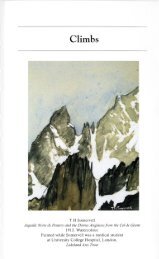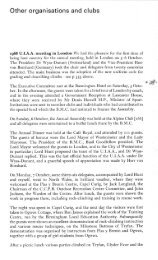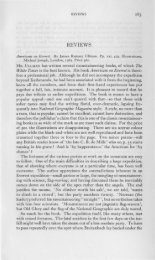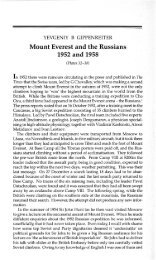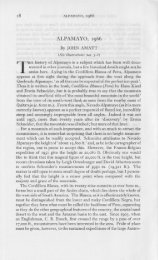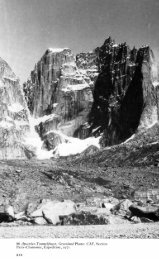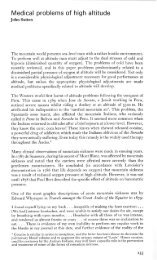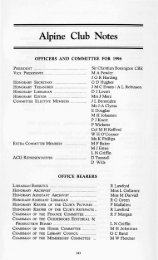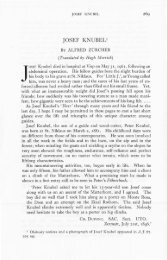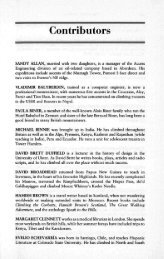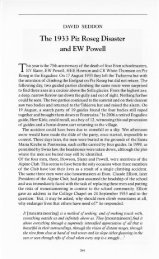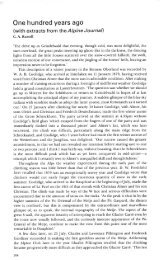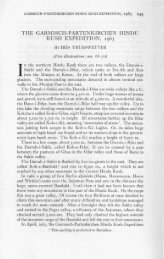AJ 2002 222-229 Ward Pundits.pdf - Alpine Journal
AJ 2002 222-229 Ward Pundits.pdf - Alpine Journal
AJ 2002 222-229 Ward Pundits.pdf - Alpine Journal
You also want an ePaper? Increase the reach of your titles
YUMPU automatically turns print PDFs into web optimized ePapers that Google loves.
MICHAEL WARD<br />
The <strong>Pundits</strong> and the Pamir<br />
The Mirza, the Havildar and the Mullah<br />
(Plates 47-50)<br />
In the 19th century an epic struggle took place between Victorian Britain<br />
and Czarist Russia on the bleakbare mountains, lonely passes and blazing<br />
deserts of Central Asia. The violent aftermath of this confrontation<br />
continues to this day, as the 'Russian Empire' in Central Asia faces an<br />
uncertain future.<br />
Stretching from the Caucasus to Tibet and China, this vast region saw<br />
many massacres, the overthrow of local rulers and retreats from many<br />
embassies. When the struggle began, the Russian and British Empires were<br />
separated by over a thousand miles but, as Russia expanded in some areas,<br />
this shrank to 50 miles or less. The threat to India seemed self-evident, and<br />
it appeared that nothing could stop Cossacks from riding over the Hirnalayan<br />
passes into Delhi, or at least settling on the Indian frontier and destabilising<br />
the largest and richest territory in the British Empire.<br />
At the start of the 19th century the newly-formed Survey of India began<br />
the monumental task of mapping the Subcontinent, initially under its two<br />
charismatic geniuses William Lambton and George Everest.<br />
Beyond the Himalayan frontiers little was known, and the independent<br />
kingdoms of Assam, Nepal, Sikkim and Bhutan did not encourage visitors.<br />
To obtain information about these Kingdoms and Central Asia generally,<br />
and thus to combat Russian influence and expansion, the Survey trained<br />
native surveyors, the pundits, to explore these unknown lands. Their use<br />
was suggested by Captain T G Montgomerie, in charge of the Survey in<br />
Kashmir, and their exploits became legendary. An extract follows from<br />
Montgomerie's initial letter of recommendation to the Secretary of the<br />
Bengal Asiatic Society. Dated 21st July, 1862, from Camp Ladak, it reads:<br />
Sir,<br />
I have now the honour to address you with reference to my proposal<br />
for employing natives in the exploration of countries which are<br />
not as yet accessible to Europeans.<br />
I think that for Central Asia, Mahommedans from our North<br />
Western frontier are most likely to supply the best recruits; for other<br />
countries, Great Tibet, etc., it may, from time to time, be found<br />
expedient to train a different class.<br />
<strong>222</strong>
THE PUNDITS AND THE PAMIR<br />
The observations to be made by such natives should be as simple<br />
as possible. The instrumental equipment should be compact.<br />
I should propose the following as the primary objects of their<br />
explorations; 1st, the latitude of important points; 2nd, the heights<br />
of ditto; and 3rd, a rough survey from point to point; 4th, an account<br />
ofeach march and ofeach remarkable place visited.<br />
From the conjoint observations of the compass and watch, for<br />
the direction and the time occupied on each march, I should hope<br />
that we would also get a fair approximation to the longitude of the<br />
various places.<br />
I think the following instruments would be sufficient, viz.:<br />
One small sextant and artificial horizon.<br />
Two small thermometers to record the temperature of air and<br />
of boiling water.<br />
Two good silver watches, etc.<br />
The above skilfully used and the results honestly recorded, would<br />
at any rate give us an intelligible idea as to the whole of Eastern<br />
Turkistan.<br />
At present we are in great doubt as to what really is the position<br />
of the various cities and places in that portion of Central Asia.<br />
After Eastern Turkistan, I should recommend exploration to the<br />
east of the Pangkong Lake district, then in the Lassa direction and<br />
so on; but in each case I should recommend the explorers to<br />
accompany menwho have been in the habit of visiting the countries<br />
in question.<br />
Initially Montgomerie chose three men - the Mirza, the Havildar and the<br />
Mullah - to explore the largely unknown area beyond the Northwest<br />
Frontier and into Turkestan. About the size of France, it contained a plethora<br />
ofranges and isolated valleys where populations lived whose loyalties shifted<br />
yearly, and who acted as a buffer between the two empires.<br />
Although Chinese Buddhist pilgrims had crossed the Pamir in the 4th<br />
and 7th centuries and a Jesuit, Benedict de Goes, travelled from Peshawar<br />
to Kabul in 1602-3, it was to be another 200 years before John Wood reached<br />
the Wakhan corridor in 1838 and explored the Upper Oxus river. In 1860<br />
the Indian traveller Abdul Mejid crossed the Pamir from south to north<br />
and in 1865 the Pundit Munphool, in disguise and with three companions,<br />
visited Badakshan, butneitherwere trained surveyors. Ofthe Pamir, situated<br />
at the junction of the Russian, Chinese and British Empires, and therefore<br />
important politically and topographically, there was little solid information.<br />
The Pamir, or 'Roof of the World' according to the Arabs, are a central<br />
group of peaks linking the Hindu Kush, Western Kun Lun, Karakoram<br />
and Western Himalaya. They separate Tibet from Turkestan and from India.<br />
They consist of mainly rounded peaks and broad treeless valleys, and have<br />
223
224<br />
THE ALPINE JOURNAL <strong>2002</strong><br />
few permanent inhabitants; but in the summer nomadic Kyrghyz graze<br />
their flocks of yak, horses, sheep and goats, and it is here that the famous<br />
Marco Polo sheep are found, as well as wild camels. The area is traversed<br />
by the Oxus river.<br />
The Mirza<br />
To find a suitable pundit, Montgomerie looked for a man who had traded<br />
in the region, who spoke the local languages and whose religion was similar<br />
to that of the local people. It was a risky assignment and suitable candidates<br />
were few. His choice finally fell on Mirza Shuza, whose mother was Persian<br />
and whose father was a Turkish trader based on Meshed, where the Mirza<br />
was born. He was already known to the Survey, where he had learned the<br />
basic techniques of surveying, but he remained in Kabul for a decade in the<br />
service of the Emir of Afghanistan. On his return, in 1867, he was given a<br />
refresher course and posted to Peshawar where he started his first survey in<br />
1868. His objective was to reach Kashgar, exploring on the way the Upper<br />
Oxus, the Pamir, and various routes to Yarkand. He was disguised as a<br />
merchant, taking with him a number of pack animals.<br />
As the passes over the mountains were blocked by winter snow, the Mirza<br />
had to make four attempts before reaching Kandahar. Since a civil war was<br />
raging, he joined Sher Ali's army which was marching north to Kabul where<br />
he arrived at the end of June. He described the town as being in a 'fIlthy<br />
condition not pleasant either to the nose or eye', and he was glad to leave.<br />
His next stop was at Kulm-Tashkurgan, from which he gained his first<br />
glimpse of the Oxus river. Eventually he reached Faizabad and presented<br />
himself to the court of the Mir. Despite being denounced as an English spy,<br />
he talked and bribed his way out of a tricky situation and left on 24 December<br />
1868. He reached the Oxus at the mud forts of Kila Punja, just upstream<br />
from where the Oxus divides. He chose to explore the southern tributary,<br />
which was fortuitous as, some years before, Wood had explored the northern<br />
tributary, and thus Montgomerie and the Survey were provided with details<br />
of the drainage of the whole of the Upper Oxus.<br />
However, the most difficult part of his journeylay ahead - a 12-day march<br />
through the Wakhan valley and then across the Pamir, with no food available<br />
for eight days beyond the last village. Despite ferocious winter gales, he<br />
continued his survey, crossed the Pamir and reached Tashkurgan in the<br />
Sirikol valley. Meeting the governor, the Mirza was forced to accept an<br />
escort. Now on unsurveyed ground, he passed through Yangi Hissar on his<br />
way to Kashgar and passed close to three unknown mountains: Kongur,<br />
Kongur Tiube and Mustagh Ata (Tagharma).<br />
Russian influence was strong in Kashgar where they had had a consulate<br />
since 1860. In 1869 the local war lord, Yakub Beg, was at the height of his<br />
powers, and his lieutenant was very suspicious of the Mirza.<br />
As soon as he arrived he learned about the two Englishmen, Shaw and<br />
Hayward, who had been detained in the province. The Mirza tried to contact
THE PUNDITS AND THE P AMIR 225<br />
Shaw who, fearing an agentprovocateur, refused to see him. Both Shaw and<br />
Hayward left Kashgar in early April 1869.<br />
Despite being closely watched, the Mirza managed to make a good survey<br />
of Kashgar, and also obtained information about the nearest Russian<br />
military post, nine days' march away. Eventually, on 7 June, he was allowed<br />
to leave with a group of pilgrims on their way to Mecca. Passing through<br />
Yarkand, the Mirza crossed the Karakoram Pass, arriving at Leh and then<br />
Dehra Dun, the headquarters of the Survey, after an absence of almost two<br />
years.<br />
The Mirza's achievements were formidable. He had produced a remarkably<br />
accurate route survey of 2,179 miles, the most important part being<br />
the 1,042 miles from Kabul to Kashgar and Yarkand, the positions of which<br />
were altered as a result. His observations in Kashgar extended those of the<br />
early Jesuits, and Montgomerie considered that, as a result, 'the chief places<br />
in East Turkestan may now be considered accurate enough for all general<br />
geographical purposes'. His work also helped to determine the watershed<br />
separating East Turkestan from the basins of the Indus and Oxus, while<br />
over and above his purely geographical contribution, he produced useful<br />
political and general intelligence about the whole region.<br />
Between 1872 and 1873 the Mirza and his son-in-law were sent on a<br />
second expedition, to Bokhara. Sadly, both were murdered.<br />
The Havildar<br />
In August 1870, a year after the Mirza's return, Montgomerie despatched<br />
another pundit over the Hindu Kush, taking advantage of the brief summer<br />
months. This was the Havildar, a Pathan and a non-commissioned officer<br />
in the Bengal Sappers and Miners, whose real name was Hyder Shah.<br />
Montgomerie sought information about a large portion of the Northwest<br />
Frontier lying between Afghanistan and Baltistan, an area which included<br />
Kafiristan, Chitral, Swat and Yasin. Local traders had provided much<br />
diverse information, but Montgomerie wanted a route survey to pull it all<br />
together. The Havildar was instructed to go north through Swat to Chitral,<br />
traverse the Hindu Kush into Badakshan, cross the Mirza's route at<br />
Faizabad, the capital, and provide a check on the accuracy of the survey.<br />
Heading north, he would then cross the Oxus and, after surveying its upper<br />
reaches, go on to Kokand, his ultimate destination.<br />
With an assistant ('the Mullah'), the Havildar left Peshawar.and within<br />
three days had left British territory by the Malakand Pass, arriving at<br />
Alladand, the capital of Swat. From here they crossed a range into Dir<br />
about 50 miles from the Hindu Kush. Virtually unexplored, the area had<br />
been the scene of a number of battles before the local tribesmen hadbecome<br />
relatively subdued.<br />
On the day before he entered Chitral, the Havildar learned of the death<br />
of Hayward who had been killed in Yasin six weeks earlier, probably by the<br />
Mir Walli, and with the acquiescence of the ruler of Chitral. Sitting between
228<br />
THE ALPINE JOURNAL <strong>2002</strong><br />
these two men at a meeting, the Havildar doubted if he would leave alive;<br />
but in his pocket he had concealed a loaded revolver, and was prepared, if<br />
necessary, to shoot both men if they showed any signs of aggression. All<br />
passed off peacefully, however, and despite being told that the road to<br />
Kokand was closed, he pressed on to Faizabad. By doing so, he was able to<br />
provide information about glaciers, snow fields and peaks of the Hindu<br />
Kush, and the gradiant of the route across the Chuksam Pass at 17,000ft.<br />
As the route north of Faizabad was also blocked, he stayed a month<br />
collecting valuable information about the area. He thenjoined a caravan of<br />
the murderous Mir Walli and returned to Peshawar on 13 December 1870.<br />
During this journey he noted with satisfaction that the Mir Walli's leg was<br />
broken and that he was in considerable pain.<br />
The Havildar's observations supplemented and confirmed those of the<br />
Mirza, and he was then sent to explore the route from Kabul to Bokhara.<br />
But there is no written record of this journey.<br />
The Havi1dar's third mission, which started from Peshawar on 19<br />
September 1873, was to map the Upper Oxus. Starting in a group of six,<br />
the Havildar disguised himself as a cloth merchant and pretended to be the<br />
servant of the head of the group, a sapper corporal- the Mullah. The latter<br />
left the group atJalalabad and went on his own exploration, as Montgomerie<br />
had planned.<br />
Heading north from Kabul, the Havildar eventually reached Faizabad,<br />
so linking up with the Mirza's previous work. Unfortunately he was<br />
prevented from completing his survey of the Oxus, but managed to survey<br />
the country to the north before heading west for a hundred miles, and<br />
returning over the Hindu Kush to Kabul. He arrived in Peshawar on 11<br />
January 1875.<br />
This journey was of great importance and significance, for it helped to<br />
demarcate the boundary between the British Empire and Russia in this<br />
remote, volatile, yet important region where the two empires met.<br />
The Havildar died of cholera in Jala1abad in 1879, possibly on another<br />
mission.<br />
TheMullah<br />
The Mullah's real name was Ata Mohammed, and he was the brother of<br />
one ofMontgomerie's first Pathan recruits. The Mullah spoke fluent Arabic<br />
and was an assistant to the Havildar on his first journey. He left him at<br />
Jalalabad on 28 September 1873 and, accompanied by a servant and a pony<br />
laden with cloth and silk, he set off for Chitral with instructions to map it.<br />
He crossed the Hindu Kush by the Baroghil Pass and in the Wakhan valley<br />
'joined up' with members ofthe Forsyth Mission* who were returning from<br />
Yarkand in the same year, 1873. The Mullah continued to Yarkand before<br />
returning to Leh via the Karakoram Pass.<br />
* See <strong>Alpine</strong> <strong>Journal</strong> 103, page 65, 1998.
THE PUNDITS AND THE PAMIR <strong>229</strong><br />
After a year's rest and debriefing, in 1875 the Mullah was asked to<br />
complete the survey of the Indus from its confluence with the Gilgit river<br />
to the plains. The primary aim of this journey was to obtain information<br />
about the tribes living adjacent to the river, who seldom left their valleys.<br />
After meeting a local man, Saeyed Amir, the Mullah travelled up the Indus<br />
valley, passing Nanga Parbat, and after reaching Gilgit he continued to<br />
Yasin. He then went west, returning to Peshawar on 1st October 1876. To<br />
allow suspicions about his true identity to die down, a year elapsed before<br />
he resumed his work, considered vital for an understanding of the geography<br />
of the region. In 1878 he was despatched in the guise of a timber merchant,<br />
but he was recognised by a ferryman who was thought to have murdered<br />
the Mullah's brother. Undeterred, he pressed on and acquired a large amount<br />
of information about the Swat valley. His survey linked with his own<br />
previous work and that of many others. However, the first comprehensive<br />
survey of the area was not finished until1895-97 following the defeat of a<br />
local uprising.<br />
The Mullah was described by the Surveyor General as 'the most<br />
painstaking and reliable of any of the Mussulman explorers that have been<br />
employed by the department'.<br />
As the Northwest Frontier region was penetrated more and more by<br />
British surveyors and military expeditions and by Russian surveyors north<br />
of the Oxus, the use of the pundits in this area became less important.<br />
However, the basic topography and intelligence about local people in this<br />
immensely complex region had been gathered by these three pundits, whose<br />
importance cannot be over-emphasised.<br />
From 1875 onwards, the efforts of the pundits were directed increasingly<br />
to the vast blank on the map of Central Asia, the Himalaya and Tibet.<br />
BIBLIOGRAPHY<br />
T E Gordon, The Roofofthe World. Edmonston and Douglas, 1876.<br />
This book contains many fascinating sketches of the region, drawn in<br />
the period when the three pundits mentioned were travelling in the area.<br />
Michael <strong>Ward</strong>, 'The Survey of India and the <strong>Pundits</strong>' in <strong>Alpine</strong> <strong>Journal</strong><br />
103,59-79,1998.<br />
Derek WaIler, The <strong>Pundits</strong>: British Exploration of Tibet and Central Asia.<br />
The University Press of Kentucky, 1990.<br />
T G Montgomerie, 'Report of the Mirza's exploration from Kabul to<br />
Kashgar' in <strong>Journal</strong> ofthe Royal Geographical Society 41,132-192, 187l.<br />
T G Montgomerie, 'A Havildar's Journey through Chitral to Faizabad in<br />
1870' in <strong>Journal</strong> ofthe Royal Geographical Society 42, 180-201, 1872.
47. The Little Pamir near Onleul, looking west - wild sheep in the foreground. (TE Cordon, 1876) (P<strong>222</strong>)
48. View from the summit of the Karakoram Pass, 18,550 feet, looking north-east. (TE Gordon. 1876) (p<strong>222</strong>)
49. The Muztagh (Tagharma Peak) from Tashkurgan, Sirikol-looking north. (TE Cordon, /876) (p<strong>222</strong>)
50. Muztagh Ata seen from the West. (Sven Hedin, 1899) (P<strong>222</strong>)



